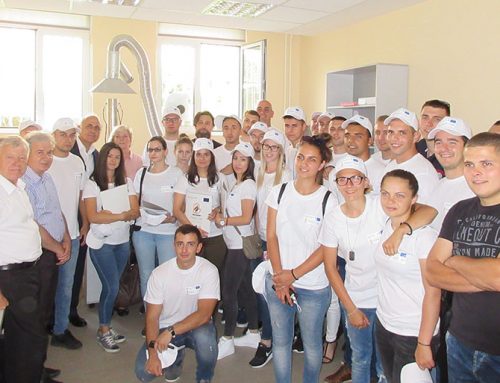Clinical centres in Serbia received through the Screening project some 30 machines to carry out mammographs, nine for colonoscopies (a microscope delivery is also planned) as well as computer equipment for 15 cytology centres. With staff trained in screening area for all three malignant diseases, the opportunity for health improvements in these areas in in Serbia is secured – a main goal of the Project.
A woman from the city of Nis, M.B. (40) discovered a small lump in her breast. Concerned and scared, she immediately visited her doctor who referred her to a specialist. There they saw that M.B. had a tumour 1.5cm in size, discovered in time and curable. Several weeks later, she was operated on. She is one of many women who through self-examination of the breast discovered a change and saved their own lives. Luckily, she visited her doctor in time.
Most women in Serbia visit their doctor when breast cancer or cervical cancer (the most frequent malignant diseases in women in Serbia) is already at a late stage, and when treatment is generally impossible. Even though in 2008 in Serbia the National Programme for early detection of cancer started (three National Programmes were adopted – for breast, cervical and colorectal cancer), mortality rates from these non-infectious diseases, to which cardiovascular diseases and diabetes are added – are devastating. According to the mortality rate and the number of patients suffering from the malignant diseases, Serbia is in the first five countries in Europe.
Until now, there was an opportune screening system in Serbia (citizens underwent examinations through their own initiative without being invited as a precaution), but there was no systemic programme of targeted exams in place to reduce mortality from malignant diseases and prevent their incidence in healthy people. Screening helps prevention, if there are certain changes in a patient they are discovered and treated in time.
In developed countries, most malignant disease is discovered at an early stage, while in the less developed countries the largest number is found in late stage. The cause lies in the non-existence of screening methods which as preventative exams are routinely implemented in developed countries.
The then Minister of Health of Serbia, MD PhD Slavica Djukic Dejanovic, announced that 2013 was to be the screening year in Serbia. During the screening process, which started in December 2012, a positive cancer result was found in 81 out of 1,771 women examined.
Data on the number of malignant diseases and mortality rates indicate that Serbia requires a well-organised screening system. The number of saved lives in one year through the screening process could be measured in the thousands, and an early diagnosis and treatment would have a significant influence for better health in the population. The introduction of screening in many European countries lasted five to seven years until it achieved more than 70% of citizens going to preventative exams – this shows that the screening was a success.
EU assistance
To assist the health care system in Serbia to establish a quality and sustainable system of screening, the European Union funded a Project “Implementation of the National Screening Programme“ with €6.6 million from IPA funds, which lasted from January 2011 to June 2013. The project created the conditions for introducing screening in Serbia as in other European countries, and one of the preconditions was the training of health care workers responsible for the screening. During the implementation of the project, which was realised in cooperation with the Ministry of Health of the Republic of Serbia, more than 1,000 health care workers (radiologists, radiographers, cytotechnicians, cytopathologists, gastroenterologists) included in the national programmes for cancer screening programmes, completed special training allowing them to work in the field of early cancer screening. The important result of this Project was the establishment of the National Cancer Screening Office housed in the Institute of Public Health of Serbia “Dr Milan Jovanovic Batut” in Belgrade.
“Only 20 percent of citizens were included in the programme of opportune screening which is insufficient. Thanks to assistance from the European Union, we succeeded through this Project in changing and improving the professional culture of screening understanding in many health workers at all levels of health care. Until two years ago, there were only 20 doctors working in Serbia handling colonoscopies. After the training we organised, another 50 doctors were trained for early screening of colorectal tumours,“said Dusan Keber, Project Team Leader.
He added that the Project contributed to the establishment of a system for screening quality monitoring and that the findings, like colorectal cancer screening plates, would be viewed twice by doctors, and kept for five years to monitor the patient’s condition. “The same applies for the mammography images which will now be ‘read’ by two doctors, and if required, will ask for the third opinion in the relevant institution,“ Keber added. “From the empty space where everything depended on the individual, we put in place a system of organised screening which is the most significant result of this project”, he said.
Within the activities of the Screening Project, a pilot project for early colorectal cancer screening was organised in 50 health care centres in Serbia. Based on the sample of around 30,000 examined (Hema screen fecal occult blood test), around 100 cases of colorectal cancer were discovered in patients who were not aware that they were suffering from this dangerous disease.
The project supported the amendment of the existing National Cancer Screening Programmes in Serbia and their harmonisation with European practice. Professor Keber, who once had worked as Minister of Health in Slovenia said that the sustainability of the prevention programme in Serbia was the key task for the future and to “find people who believe in screening.”
New cases of cancer discovered
“The project prompted great changes, both with patients (a lot of cases of colorectal cancer were discovered in various phases and the significance of the timely examination was recognised within the portion of the population where the pilot project was implemented), and trainees who had the opportunity to standardise, improve and compare their colonoscopy techniques with other doctors, as well as mentors who had to raise their technique to the highest possible level. A lot of young doctors got the opportunity to start their colonoscopy training at the right time. Equally health care public awareness was changed in relation to ‘big and small centres’ because the training allowed everyone to be equal,” said Goran Nikolic, gastroenterologist from the Clinical-hospital centre Bezanijska Kosa, who participated in the Project.
“Where that was necessary, part of the training the reorganisation of the endoscopic units at the beginning was performed in line with the modern trends and through the project activities. Through four endoscopic workshops the participants were able, for the first time in Serbia, to participate actively in workshops the way it’s done in the developed countries”, Nikolic said.
In a lot of countries where such screening was introduced such as Slovenia, Sweden and Finland, between four and seven years passed before citizens started to regularly respond and come for check-ups. In Slovenia, 70 percent of women undergo regular check-ups at the gynaecologist, and the mortality rate from cervical cancer has decreased by 30 percent in the last five years. The health care system in Slovenia succeeded in the establishment of screening from 2003, by organising a campaign that included all doctors, who later received money through a payment per service system if they examined a larger number of women. Since screening was established in Slovenia, there has been roughly 6,000 fewer deaths during middle-age from non-infectious chronic diseases compared to 15 years earlier.
The screening was introduced in Finland 45 years ago, and the mortality rate is today 80 percent less. In other European countries, such as England and Iceland, the mortality rate also decreased which has been directly linked to the quality of the screening system put in place.
If there are enough people who believe in the screening process, Serbia will improve the poor data on the number of cancer patients that it faces today.
The European Union invested more than €146 million of assistance to the health care system of Serbia from 2000 to present day.




